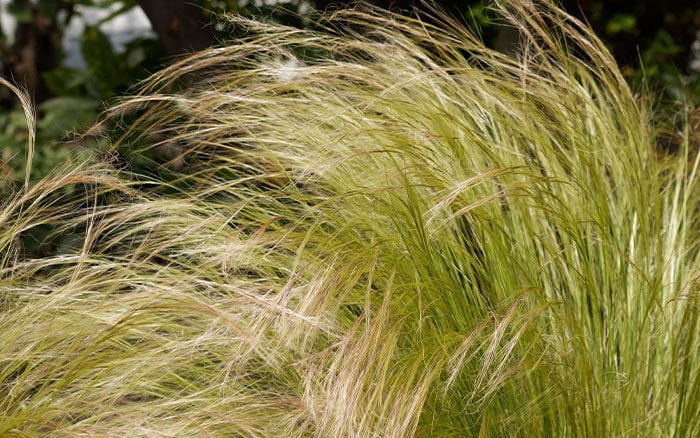Updated 16/06/2025
It’s quite common to read garden design articles where the designer writes about planting in drifts. But what is drift planting?
Quite simply drift planting is placing groups of the same type of plant together and then repeating those same plant groups. This is often done in curving, informal patterns, along and within a border containing other types of plants. As this mimics the natural spread of pllants growing in the wild.
Using several of the same types of plants throughout a plant border creates a peaceful and harmonious feel in the planting scheme. As the eye will glide across the area rather than jumping around a jumble of different plants.
It doesn’t matter if your plant borders are large or small, or your garden style is traditional or modern. The concept is the same and it’s an easy way to create impact.
Best types of plant to use in drift planting
The types of plant that work well are mound-forming ornamental grasses such as Stipa tenuissima ‘Pony Tails’ (Mexican feathergrass), perennial plants that produce masses of flowers over a long period like diasica, geum, phlox or asters. Also, groundcover plants such as Origanum vulgare ‘Aureum’ (Golden marjoram).
It’s a great way of creating maximum impact in the border, especially if using a brightly-coloured perennial that flowers for months on end such as Geranium ‘Rozanne’ (Hardy geranium).
Choose plants that flower at different times of the year so pollinating insects have an extended time food source.



Areas where drift planting can be used
Flower borders
Shrubberies
Slopes and banks
Rockeries
Areas around the base of specimen trees or shrubs
How many plants should be grouped together?
It’s generally recommended that odd numbers of plants should be used in the drift groupings such as 3, 5 or 7. The odd number creates an irregular, more relaxed looking shape, which in turn gives the impression of a more natural arrangement.
After all plants naturally occurring in the wild rarely grow in a straight line!

The other advantages of drift planting
Drift planting is low maintenance, as plants grouped closely together tend to cover large areas of bare earth, which in turn can cut down on weeding.
When larger numbers of the same plant are flowering en masse it makes it easier for pollinating insects like bees and butterflies, to find. Many of them look for nectar and pollen from plants of the same species.
Mass planting with the same plant can make it quicker and easier to fill the flower border quicker as it simplifies plant choices!
For a garden design that looks natural and effectively distributes colour and variety, consider planting in drifts.
For more great gardening advice, make sure you head to my YouTube Channel. Make sure you’re subscribed with notifications on so you don’t miss any of my new videos.
Frequently Asked Questions:
1 – What does ‘planting in drifts’ mean?
Planting in drifts means grouping the same plant in natural-looking, repeated clusters. These groups are usually arranged in gentle, flowing shapes, creating a more harmonious and relaxed design. Just like plants growing in the wild.
2 – Is drift planting suitable for small gardens?
Absolutely. Whether your garden is large or small, planting in drifts adds structure and cohesion. In smaller spaces, it can even make borders feel less cluttered and more spacious by simplifying the planting layout.
3 – What kind of plants work best in drifts?
Aim for odd numbers like 3, 5, or 7, which create a more organic and natural feel. Avoid straight lines or even-numbered blocks. Nature rarely grows that way, and your planting will look more relaxed if you mimic that.
4 – What kind of plants work best in drifts?
Choose plants with long flowering seasons or strong foliage, such as ornamental grasses, hardy geraniums, asters, and groundcover herbs like golden marjoram. Repeating these helps reinforce your garden’s rhythm and flow.
5 – What’s the biggest benefit of drift planting?
Drift planting offers maximum impact with minimal plant variety. It’s an effective way to create a natural, cohesive look whilst saving time choosing and caring for dozens of different species.

Leave A Comment